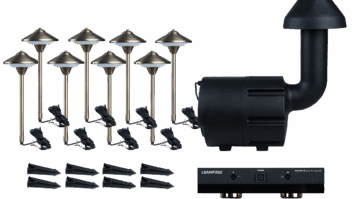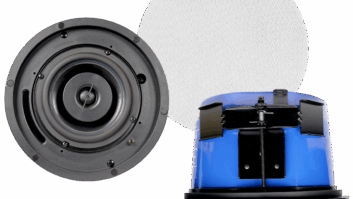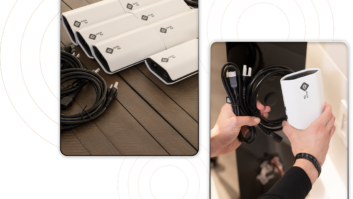In my job as a reviewer I’m fortunate enough to get to play with oodles of audio gear. And much of it, fortunately, is really amazing stuff–stuff I can enthusiastically recommend and stuff that occasionally even evokes an exclamation point. But it’s been a long time since any particular piece of review gear moved me in a way that really reached down into the depths of my lizard brain, circumventing the frontal lobe and the Broca’s area of my squishy gray matter, to tug on something more primal, more meaningful, less tangible, and outside the reach of measurements and specs and connectivity concerns.

After hauling the massive bulk of Polk Audio’s flagship LSiM707 floorstanding loudspeakers into my media room, along with the accompanying LSiM706c center channel and LSiM702F/X surrounds, I popped in the DVD-Audio release of Beatles: Love, kicked back in my theater seat, queued up “Here Comes The Sun/The Inner Light,” and literally started weeping like a little girl with a skinned knee. Sitting in the sweet spot of some of the most balanced-yet-powerful audio I’ve experienced in ages, I seriously started sobbing so hard that Bruno, my pit bull, dragged all 75 pounds of his massive, blocky frame into my lap and curled up there to comfort me.
Chalk it up to exhaustion if you like–at nearly 100 pounds apiece setting up the LSiM707s shouldn’t be a one-person job–but I think it’s something more than that. Or something less, perhaps. Because, despite their height, their depth, their gorgeous curved monolithic design and hardwood veneer cabinetry. Despite the gargantuan girth of the LSiM706c. Despite the unusual form of the LSiM702F/X–despite any number of clues that would lead you to believe that the new LSiM system has its own distinct “voice,” this is, without a doubt, one of the most invisible-sounding speaker systems I’ve ever had the pleasure of lugging into my home. The last time I was so moved by a speaker system was during my visit to Wisdom Audio to review their $40,000, 81-inch planar magnetic LS4. At a mere 51 inches and 99.2 pounds, the $1,999.95 LSiM707 seems positively minuscule by comparison, and its driver array much more conventional.
It’s not entirely conventional, though. Yes, we’re still in the realm of woofer and tweeters here, but the LSiM707 is adorned from top to (literally) bottom with drivers, including two 6×9-inch woofers, a 6.5-inch mid-woofer, and a one-inch ring tweeter positioned below its 3.25-inch mid driver. The LSiM706c center carries over the same tweeter-below-mid-driver array, and drops the oval woofers for two 6.5-inch mid-woofers, in addition to replacing the 707’s down-firing PowerPort bass vent with two rear-firing ones.
Perhaps it’s the mid-over-tweeter design; perhaps it’s all of the internal bracing and isolated interior airspace for each driver—perhaps it’s all of those factors combined—but for whatever reason, the LSiM706c, when properly configured is, is one of the finest horizontal center channels I’ve ever heard, and makes a gorgeous complement to the 707.
In my case, that proper configuration required a choice between a lower crossover point and fussier positioning. Given the incredible bass extension of the speakers–effectively 50Hz for the center and 38Hz for the towers–my initial inclination was to run them closer to full range, because honestly, the system generates an amazingly satisfying amount of staggering bass even without a subwoofer. Even with the ingenious porting design, though, I found myself unable to get the front speakers far enough away from the walls behind them to really let them breath. So, in the end, I let the Anthem Room Correction of my D2v processor do its thing and set a more cinematic (although arguably incorrect from a THX standpoint) crossover point of 60Hz for the towers and 65 for the center and surrounds. The center could probably effortlessly be crossed over a little lower in most cases, but wedged as tightly as it is into my TV stand, there’s a weensy bit of bass resonance to worry about in my setup that won’t apply to all situations, especially if you opt to stand-mount the center.

In any case, with crossovers set thusly, the front and center became way less picky about placement, and unified into a seamless, transparent whole that didn’t merely bring me to tears with the Beatles, but rendered dialogue and front soundstage effects in movies with the sort of big-screen verisimilitude you simply wouldn’t expect from speakers at this price. Or any price, for that matter. Dialogue is not only rendered with a spooky clarity that pulls intelligible and lifelike voices out of even the densest action-packed mixes (I’m looking at you, Lord of the Rings), but best of all, the LSiM706c’s wonderful dispersion delivers all of that crystal clear dialogue way over to my wife’s favorite seat at the edge of the room. There simply isn’t a bad seat in the house anymore.
If I had one nit to pick about the 707 and 706c, it’s with the grilles. They attach magnetically, which is nice, but–especially with the towers–if the grilles aren’t absolutely flattened to a fritter-like state, they struggle to cling to the speakers. I’ve also found that the grilles do introduce a noticeable roll-off in the very highest frequencies, which I would normally appreciate, since my ears are particularly sensitive to the 16-17kHz range. But, the LSiMs generate such crystal clear, distortion-free sparkle in that neighborhood that it’s a little unfortunate to hear them rolled off even a smidge.
Despite that, I left the grilles on, because the LSiM702F/Xs really need them, aesthetically speaking (the surrounds’ grilles aren’t magnetic, and attach more firmly), and the timbre mismatch of naked fronts and clothed surrounds took away from the system’s incredible uniformity.
That uniformity is all the more amazing when you consider just what a different sort of speaker the LSiM702F/X is. From looks alone (especially with the grille on), you’d guess it’s a bi-pole or di-pole on-wall surround speaker design. But no, all of the surround speakers’ drivers (the same found in the 707 and 706c, with the same tweeter-under-mid configuration, and a single 6.5-inch mid-woofer) are driven in phase. The odd thing is that they point in somewhat different directions. The mid-tweeter array (which Polk calls its dynamic sonic engine) is positioned on an angle, such that, with the mirror-imaged pair of LSiM702F/Xs on the back wall, about four feet behind and seven feet to either side of me, that particular set of drivers points right at my head. The mid-woofer, meanwhile, points straight out into the room.

It’s a puzzling, intriguing driver configuration about which I was quite dubious at first blush, but a moment’s listening put any doubts to rest. Just a pair of LSiM702F/Xs in 5.1-channel configuration bridge the gap between front and rear soundstages beautifully, and despite being dwarfed by the towers I usually use as surrounds in my reference system, they add an incredible amount of cradling bottom end of the back of the room, blending wonderfully with my subs, and really solidifying the surround sound effect in new and startling ways.
The LSiM702F/Xs are also designed with a down-firing PowerPort bass vent, and a wall-distance switch that acts as a notch filter to tame low-frequency performance if you wish to wall mount them. And if you have the space, I highly recommend that you do. They sound wonderful out from the wall a few feet, on stands (although you’ll definitely want to install the rubber feet to combat a bit of resonance if you go this route), but with the notch filter engaged and the speakers mounted on the wall, I felt that I got the best timbre matching from the system as a whole. And when mounted on the walls, resonance is surprisingly not an issue at all.
The unique mirror-image design of each LSiM702F/X pair also makes them equally adept as the only surround speakers in a 5.1 system or rear-and-side surround speakers in a 7.1 system, although if you go the latter route, you might want to experiment with bringing them forward-or-backward on the sides and a little further in-or-out in the rear than you might otherwise. I did have to move the right LSiM702F/X in few inches to avoid some corner loading in my room, and scooted the left one in a bit just to match, but even with that slightly tighter spread, the pair paints an astoundingly wide, rich, deep surround soundfield that I honestly just want to wallow in.
Placement particulars aside, I remain rather blown away by the LSiM702F/X in and of itself. Even when compared to the towering robustness, incredible imaging, and delightful sonic neutrality of the 707s, and the awe-inspiring dispersion capabilities and effortless transparency of the 706c, the LSiM702F/X is an absolute standout—an inventively designed speaker custom tailored to one specific purpose, which it handles amazingly well.
The important point, though, is that, when taken as a whole, this is one of the most gorgeously performing, unified surround systems I’ve auditioned in ages, and on their own–sans subwoofer–the 707 makes for the sort of two-channel hi-fi setup that you would swear cost at least twice as much (perhaps much more), even taking into consideration Polk’s traditionally value-friendly place in the market. Combine that with a virtually compromise-free horizontal center speaker and some of the neatest surrounds I’ve come across in ages, and I think I’ve found my new reference speaker system.
866.764.1801
Kudos
Polk’s flagship LSiM setup is one of the most neutral, beautifully balanced, and cohesive surround speakers systems I’ve heard in ages, with towers that absolutely shame most hi-fi stereo speakers costing many multiples as much.
Concerns
Other than the grilles, the only minus worth noting is that setting up the 707s is definitely a two-man job.
Product Specs
LSiM707
* Tweeter: 1″ (2.54cm) Dynamic Balance enhanced ring radiator tweeter
* Midrange: 3.25″ (8.26cm) Dynamic Balance driver with super cell aerated polypropylene cone
* Mid / Woofer: 6.5″ (16.51cm) Dynamic Balance driver with super cell aerated polypropylene cone
* Subwoofers (2x): 6″x9″ (22.86cm x 15.24cm) Dynamic Balance oval drivers with super cell aerated polypropylene diaphragms
* Total Frequency Response20Hz-40kHz
* Upper -3dB Limit: 30 kHz
* Lower -3dB Limit: 38 Hz
* Nominal Impedance: 8 ohms
* Efficiency: 88 dB
* Crossover: Orth crossover design (3 kHz/300 Hz/100 Hz)
* Recommended Amplifier Power: 20-300 watts per channel
* InputsDual gold-plated binding posts
* Dimensions: 50-13/16″ (129.06cm) x 9.5″ (24.13cm) x 18-7/16″ (46.83cm) (hwd)
* Mid-High Array Enclosure Type: Sealed
* Subwoofer Enclosure Type: Dual PowerPort bass venting
* Product Weight (each): 99.2 pounds
* Price: $1999.95 each
LSiM706c
* Tweeter: 1″ (2.54cm) Dynamic Balance enhanced ring radiator tweeter
* Midrange: 3.25″ (8.26cm) Dynamic Balance driver with super cell aerated polypropylene cone
* Mid / Woofers (2x): 6.5″ (16.51cm) Dynamic Balance drivers with super cell aerated polypropylene cone
* Total Frequency Response: 30Hz-40kHz
* Upper -3dB Limit: 30 kHz
* Lower -3dB Limit: 50 Hz
* Nominal Impedance: 8 ohms
* Efficiency: 88 dB
* Crossover: Orth crossover design (2.8 kHz/280 Hz)
* Recommended Amplifier Power: 20-250 watts per channel
* Inputs: Dual gold-plated binding posts
* Dimensions: 9″ (22.86cm) x 28.75″ (73.03cm) x 13-13/16″ (35.08cm) (hwd)
* Mid-High Array Enclosure Type: Sealed
* Midwoofer Enclosure Type: Dual PowerPort bass venting
* Mounting Options: Shelf; Speaker stand
* Product Weight: 42.3 pounds
* Price: $1199.95 each
LSiM702F/X
* Tweeter: 1″ (2.54cm) Dynamic Balance enhanced ring radiator tweeter
* Midrange: Midrange: 3.25″ (8.26cm) Dynamic Balance driver with super cell aerated polypropylene cone
* Mid / Woofer: 6.5″ (16.51cm) Dynamic Balance driver with super cell aerated polypropylene cone
* Total Frequency Response: 40Hz-40kHz
* Upper -3dB Limit: 30 kHz
* Lower -3dB Limit: 55 Hz
* Nominal Impedance: 8 ohms
* Efficiency: 88 dB
* Crossover frequencies: 2.4 kHz/240 Hz
* Recommended Amplifier Power: 20-200 watts per channel
* Inputs: Gold-plated binding posts
* Dimensions: 16.25″ (41.27cm) x 19-23/25″ (50.60cm) x 6 3/4″ (17.14cm) (hwd)
* Mid-High Array Enclosure Type: Sealed
* Midwoofer Enclosure Type: PowerPort bass venting
* Mounting Options: Keyhole slots for wall mounting; Pedestal for shelf mounting
* Product Weight (each): 28.9 pounds
* Price: $1,499.95 per pair






